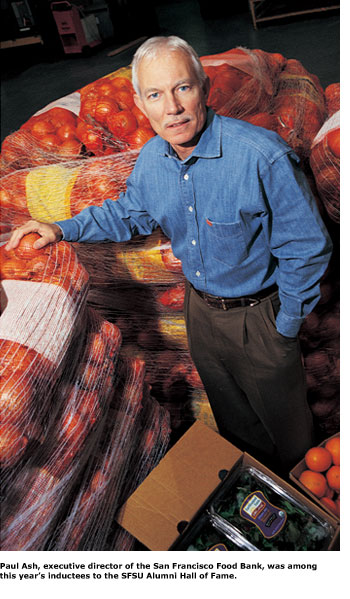 |
| |||
 The Food Network The Food NetworkOn a Friday morning in March, Paul Ash (M.S., '84) walks through the San Francisco Food Bank's Potrero Hill warehouse, stopping to survey the bundles of fresh asparagus that have just arrived. Stacked upright, not a wilting one among them, the spears stand at attention during the executive director's impromptu inspection. "It's exciting," Ash says as he dodges a forklift to point out a good-looking parcel of pears. "Five years ago you wouldn't see produce like this coming in here." What changed? "We went after it," he says. For the past 16 years, Ash has channeled his energy into feeding the hungry in San Francisco. Under his leadership, the Food Bank has become the only organization in the city equipped to collect millions of pounds of donated food and distribute it to children, adults and senior citizens living at or near the poverty level. Last year, Ash, a staff of 50, and volunteers who do everything from sorting and shelving donations to driving delivery trucks, brought 23 million pounds of food to hungry San Franciscans, translating to more than 50,000 meals each day. John Meehan (B.A., '95), executive director of the Seniors Emergency Grocery Bag Program in Chinatown, traces the Food Bank's success to Ash's commitment to his cause, his skill at hiring and his accessibility. "Paul's a go-getter, a can-do type of guy," he says. Ash fell into the rhythm of agriculture at an early age. As a child he and his family moved frequently to follow his father's construction jobs, but summers were spent on the Oklahoma farm where his grandparents lived off their crops and livestock. Ash's interest in food production and distribution led him to the University of California, Davis where he earned his undergraduate degree in agricultural economics. Before he enrolled in the business administration program at SFSU, he spent two years in Malaysia as a Peace Corps volunteer helping young people start small farming operations. At SFSU, Ash found professors with real-world experience and he picked up the business skills that he relies on every day, whether he's working with auditors, hiring staff or analyzing inventory. His favorite class was Professor Paul Rech's "Operations Analysis" because of the lively lessons as well as the connection he made with one special classmate, Silvia Fernandez, today his wife of 20 years. The Food Bank began inside a cramped building not far from its present location on Pennsylvania Avenue. Unlike the mammoth warehouse of today, there were no loading docks, no refrigerators or freezers, no bathrooms in the building -- and the roof leaked. "Now that I think about it, I didn't see the place until my first day at work. All the interviews were held elsewhere," Ash says with a smile. "Maybe that's something the business professors at State should mention in class." Back then, drips from one very leaky roof ruined dry goods, and potential donors who visited the Food Bank often left unimpressed. The Loma Prieta earthquake of 1989 occured two years after the Food Bank was incorporated and provided a crucial turning point for the organization. "It was an opportunity for us to see if we could turn on the juice and really perform," Ash says, recalling how staff and volunteers put in long hours to help displaced residents of the Tenderloin and South of Market neighborhoods. Their hard work inspired donors to contribute to a capital campaign for a new warehouse. "It was a triumph for us," Ash says. Today, an expanding network of growers, manufacturers and grocers across the country helps the organization channel fresh, frozen, dry and canned food through more than 450 nonprofit anti-hunger programs in the city. The Food Bank reaches tens of thousands of individuals each month at senior centers, schools, soup kitchens and other human service agencies with meal programs. Susan Fox, a fundraising consultant and former Food Bank board member, was among those who raced to cover food with tarps in the early days. "Paul has done a great job, really raised the status of the organization," she says. "It's grown by leaps and bounds, and Paul has taken an important leadership role in calling people's attention to the hunger problem." With the high cost of living in San Francisco, the Food Bank often serves people who don't qualify for government assistance but "[We serve] people who have jobs -- even multiple jobs -- seniors, retired people and grandparents raising their grandchildren, people who spend the money they do earn on rent or prescription medicine and don't always have enough left over for food," he says. Ash quotes an elderly woman who he says put it best: "There's just too much month left at the end of the money." The Food Bank manages two relief programs at the federal level and also advocates for improvements in government food programs and policies. Ash enjoys watching the Food Bank in action. Recently he visited the Dr. Charles R. Drew College Preparatory Academy, where 70 percent of children rely on federal assistance to purchase school lunches. A new partner with the Food Bank's Healthy Children Pantry Program, the Bayview-Hunters Point school now provides parents with a bag of healthy food on a weekly basis. The Food Bank aims to keep these pantries operating year-round. During the summer months, when children are not able to take part in school lunch programs, hunger is often on the rise. Ash says it's difficult for him to imagine the anguish of mothers and fathers who aren't able to put enough food on the table for their families. Having children of his own -- 10-year-old Elena, who brings her friends to the Food Bank to volunteer on the weekends, and 3-year-old Ethan -- has only heightened Ash's sensitivity to the problem. "To know that we're helping these parents feed their children feels especially good," he says. "It's about as good as it gets." -- Adrianne Bee | ||||










